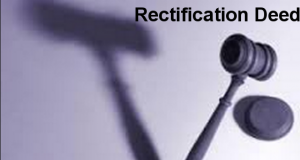Rectification deed is a document correcting the mistakes of facts in the original / principal deed.
Mr.Sampath had negotiated to purchase a residential site at Peenya for Rs. Four lakhs and got the sale deed registered. After receipt of the sale deed, he found, that the dimensions of the area are wrongly mentioned in the schedule as East to West 40' and north to south as 30' instated of East to West 30' and North to South 40'. Mr.Rajagopal had a similar problem in the sale deed, the boundaries of property purchased are wrongly mentioned.
The case of Narasimhan is slightly different, he has purchased two different properties from a common vendor under a common sale deed including both the properties under single schedule. Mr. Narasimhan was for a pleasant shock to find that encumbrance certificate did not reflect the sales in respective property schedules, but was combined under a single property schedule.
Such instances are many. Many mistakes creep into the sale deeds, as they are not properly verified and compared with the title deeds, revenue records, and at times are not drafted by professionals / advocates. Sometimes, the area of the property, survey numbers, location, boundaries, municipal numbers, description and number of floors, are wrongly written. Names of parties may be mis-spelt, amount of consideration may be wrong, easementary rights may not have properly dealt. In many cases, the real contention of parties to the deed may not have been reduced into writing.
Such mistakes, errors in the deeds should be corrected by another document. This is called rectification deed. It is equitable relief granted by the Court of equity based on doctrine of mistake. In order to have deed of rectification, there must be mutual mistake and the original deed does not reflect the true intention of parties.
More important is that mistake should be of facts and not a mistake of law. But, mistake of foreign law is considered as mistake of fact. Sections 20 and 21 of Indian contract act deals with this aspect.
When the parties to deed, agreed to modify, add, delete the terms of original deed to bring in true intention it is necessary to reduce such modifications into writing properly and pay the requisite stamp duty.
Rectification Deeds are executed on mutual consent of the parties to main deed, all the parties who have executed the main deed should join in execution. But real problem lies where the mutual consent is not possible. In such cases, the recourse is to file a suit under section 26 of Specific Relief Act 1963. This section provides, where the real intention of the party is not properly expressed in the documents because of mistake of fact or fraud, either the party or his representative may institute a suit to have the deed rectified.
The section also empowers the court to direct the rectification of an instrument if the court satisfies that the deed does not express the real contention of the parties. Further the contract in writing may first be rectified and then if the party claiming rectification has so prayed, in his pleading and the court thinks fit, may be specially enforced. This relief will be granted, if it has been specially claimed. If it has not claimed such relief in his pleadings, the court at any stage of the proceedings may allow him to amend the pleadings. This is entirely discretionary and when granted does not prejudice the rights acquired by the third party in good faith for value.
If the original deed is registered, the corresponding rectification deed also require Registration. The stamp duty and registration charges are payable as prescribed by respective states.
For More Information:

No comments:
Post a Comment